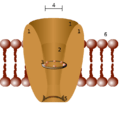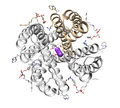Ion channel facts for kids
An ion channel is a pore-forming protein that helps to establish and control the small voltage gradient across the plasma membrane of all living cells (see resting potential) by allowing the flow of ions down their electrochemical gradient. They are present in the membranes that surround all biological cells.
An ion channel is an integral membrane protein or more typically an assembly of several proteins.
The 2003 Nobel Prize in Chemistry was awarded to Peter Agre and Roderick MacKinnon for their discovery of ion channels.
- Bertil Hille: Ion channels of excitable membranes, 3rd ed., Sinauer Associates, Sunderland, MA (2001). ISBN: 0-87893-321-2
Images for kids
-
Schematic diagram of an ion channel. 1 - channel domains (typically four per channel), 2 - outer vestibule, 3 - selectivity filter, 4 - diameter of selectivity filter, 5 - phosphorylation site, 6 - cell membrane.
-
Birth of an Idea (2007) by Julian Voss-Andreae. The sculpture was commissioned by Roderick MacKinnon based on the molecule's atomic coordinates that were determined by MacKinnon's group in 2001.
See also
 In Spanish: Canal iónico para niños
In Spanish: Canal iónico para niños




